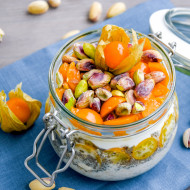Growing and caring for physalis: step-by-step instructions for a gardener
Content
Description and biological features
Physalis, which is commonly called the Chinese lantern, earthen cranberries, emerald berries and cherries, belongs to the most numerous genus of nightshade crops. In nature, there are about 1200 species. The shrub grows mainly in Europe, Asia, North and South America.

Physalis is a herbaceous one or perennial crop. There are shrubs with branched, geniculate, angularly curved and erect stems. It is extremely rare that the upper half of the stem has a fleecy edge. The height of the herbaceous shrub ranges from 20 to 120 cm. The upper leaves are formed oppositely, the lower ones alternately or in pairs. The color of the leaf blades is deep green.
Single-type axillary inflorescences are formed along the entire length of the stem axis. Swollen bell-shaped cups. The flower has a bright color: orange, rich yellow or emerald. Inside the "lanterns", two-nested berries of red and orange colors are formed.
Video "Cultivation of physalis: from sowing seeds to harvesting"
This video tells how to grow vegetable physalis of the Confectionery variety in the garden or in the vegetable garden.
Types and varieties of physalis
Only 5 main types of culture are represented on the territory of Russia. It is noteworthy that the plant can be planted and grown in any region, including the Volga region, Siberia and the Urals. The main rule of gardeners is the choice of a physalis variety corresponding to the climatic and geographical conditions of growth.

Vegetable
Mexican tomato or vegetable physalis is used in cooking. Dishes from an exotic plant are found in the best vegetarian restaurants in the world. The fruits are eaten fresh, salted and pickled. They are used for making salads, sauces and seasonings, candied fruits and sweets, jam, marshmallows and preserves.
The best representatives of the salad-canning group are the Konditerskiy, Moskovskiy early, Korolek, Krupnoplodny and Gribovskiy soil varieties.
Strawberry and berry
The second group is strawberry physalis, which is often called berry, pubescent and Florida. Miniature fruits the size of a pea have a persistent aroma and pleasant taste. Technical maturity is determined by the color of the berries. At the time of harvest, the skin of the fruit should be painted in a rich amber color. About 3 kg of berries are harvested from one adult bush.
Common varieties: Philanthropist, Strawberry and Candy.
Raisin
Most gardeners combine this type of "Chinese lantern" with strawberry.However, the raisin variety is distinguished by its taste characteristics - the berries are characterized by sourness and mild notes of pineapple. In the juice you can feel the familiar taste of tangerine.
Peruvian
A refined sweetish-sour taste with a characteristic grapefruit aroma is a distinctive feature of Peruvian Physalis. The small, flattened berries have an orange-strawberry aftertaste.
The brightest representatives of this exotic group are the Kudesnik and Columbus varieties.
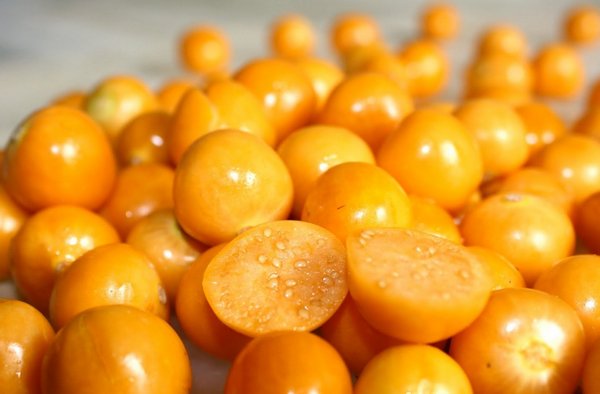
Decorative
The very name of the plant suggests that the herbaceous shrub is used in landscape design. The average height of the shrub is 60 cm. The decorativeness of the culture manifests itself in the autumn period, when other plants begin to shed their foliage and prepare for winter. The ornamental bush is changing for the better - bright orange flowers appear. Gradually, the "lanterns" lose their color, cherry-red berries are visible through the transparent petals.
Popular varieties: Longifolia and Franchet.
Growing physalis from seeds
Experienced gardeners are of the opinion that physalis is a dream plant for a beginner or "lazy" grower. Subject to a number of simple growing rules, the culture is highly viable and has a tendency to ripen fruits quickly.
Sowing
Sowing seeds for seedlings is performed at the very beginning of spring. In regions with a temperate climate, seeds are planted in open ground, in the northern regions - in wooden or plastic boxes.
Before sowing, a selection of quality material is carried out. All seeds are immersed in a salt solution (5%). The floating seeds are thrown away. The specimens that have sunk to the bottom of the container are washed with a solution of potassium permanganate, rinsed with running water and dried. The seed prepared in this way is planted in shallow grooves with a length of no more than 0.3 m. The scheme for planting seeds in wooden boxes and boxes is 6x8 holes.
Seedling care
Depending on the climatic characteristics of the region, the first shoots appear after 7–28 days. For good growth and development, seedlings must be protected from drafts and cold. The optimum temperature range is +20 ° C. Diffused bright light promotes active growth and rapid maturation of seedlings.
As they grow, young plants are fed with chicken droppings diluted in water (20: 1). Remember to moisten the soil before fertilizing.
Picking
The picking of seedlings is carried out after the formation of two or more leaf plates. You need to work very carefully so as not to injure the root processes. The dived plants are transplanted into separate containers and cultivated separately until they are planted in open ground.
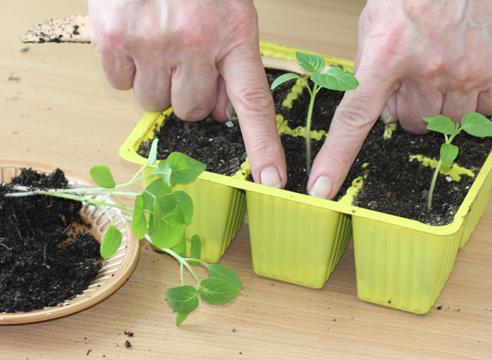
Planting physalis in open ground
The next stage of physalis agricultural technology is planting seedlings in open ground. At the same time, it is important to adhere to a certain placement scheme and observe the landing dates.
What time to plant
The optimal period for planting seedlings in open ground is determined by the plant itself. The bush should have at least 5-6 correctly formed leaves. The procedure should be carried out on a warm and calm day. Therefore, check the weather forecast in advance.
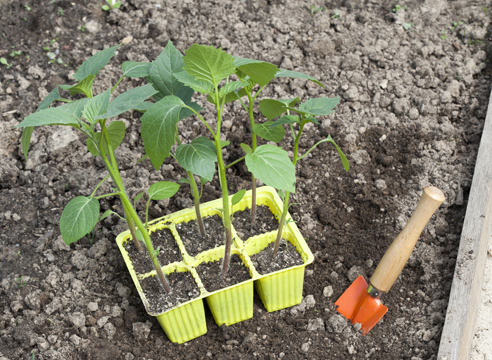
Landing features
Physalis loves sunlight and neutral or slightly alkaline soil. Avoid areas where tomatoes, peppers, eggplants, and potatoes were previously grown. For 15–20 days, the site is fertilized with humus and wood ash.
Seedlings are planted in a checkerboard pattern. The recommended step between the planting pits is 50 cm. First, 1–1.5 liters of water is poured into the hole. Without waiting for the water to be absorbed into the soil, the seedlings are planted. Please note that the branched root system of the seedling must straighten out on its own.Then the plant is covered with soil and mulch abundantly with peat.
Caring for a flower in the garden
Despite the fact that growing physalis is considered a simple and easy process, improper care can lead to disease or death of the plant. Let's consider the basic rules of caring for a "Chinese flashlight".
Watering, fertilizing and feeding
Watering shrubs should be systematic - as the topsoil dries out. After each moistening, the soil is loosened. Loosening prevents the active growth of the weed grass and promotes the supply of oxygen to the roots.
Physalis prefers feeding to organic fertilizers. During the growing season, the plant is fertilized with mullein or chicken droppings diluted in water in proportions of 15: 1 and 10: 1, respectively.
Reproduction
Physalis is most often propagated by the seed method. The decorative type of shrub can be propagated by layering or cuttings. When propagating by layering, the lower lateral shoots are bent to the ground, fixed with metal brackets and sprinkled with earth.
Separate shoots from the parent bush when each of them has at least 5-6 leaves.
Cuttings are carried out in the middle of summer - in July. The upper parts of the shoots, which have several developed internodes, are cut off and half-rooted in loose soil. At first, the cuttings are under a film or agrofibre. The cover is removed when the leaf plates have regained their original turgor.
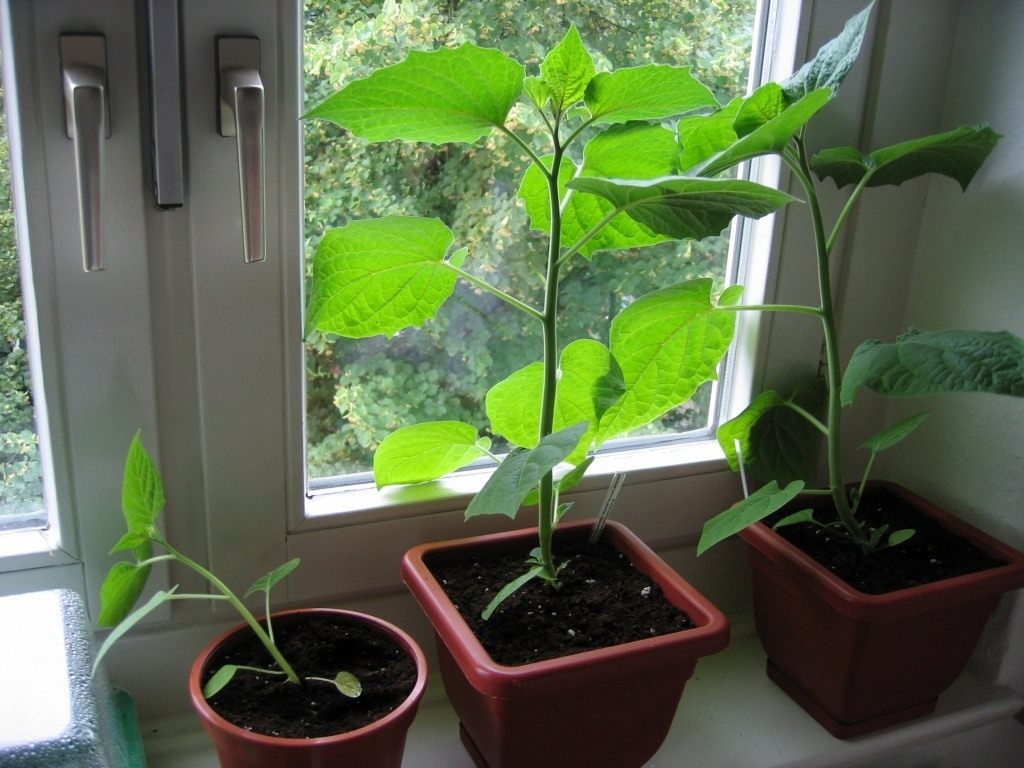
Preparation for wintering
On the eve of winter frosts, "Chinese lanterns" are cut almost to the very bottom. Then the plants are insulated with sawdust, hay, pine spruce branches, and covered with non-woven material on top. It can be agrofibre, white propylene bags, or burlap.
Diseases and pests
Physalis is considered the most hardy member of the Solanaceae family. In rare cases, shrubs infect pathogens of late blight, black leg, mosaic, fusarium, white and gray rot. The culture can become an object for attacks by wireworms, bears and aphids. To protect plants from diseases and harmful insects, modern fungicidal and insecticidal preparations are used.
In order to prevent diseases and pest infestations, it is recommended to spray the crown with Bordeaux liquid (3%).
Ideas for decorative compositions with physalis
Physalis is used in landscape design to decorate garden gazebos and summer kitchens. The plant is also used to create interesting decorative compositions: watering cans and teapots, garden benches and chairs, topiary and lanterns. The best "neighbors" are immortelle, kermek, lunar, gypsum lover and spherical gomphrena.
Autumn is not a reason for sadness and despondency. This is how you can characterize the bright physalis bushes. Adhering to the rules and recommendations described above, plant such an interesting plant on your site that will constantly attract attention and please the eye.



